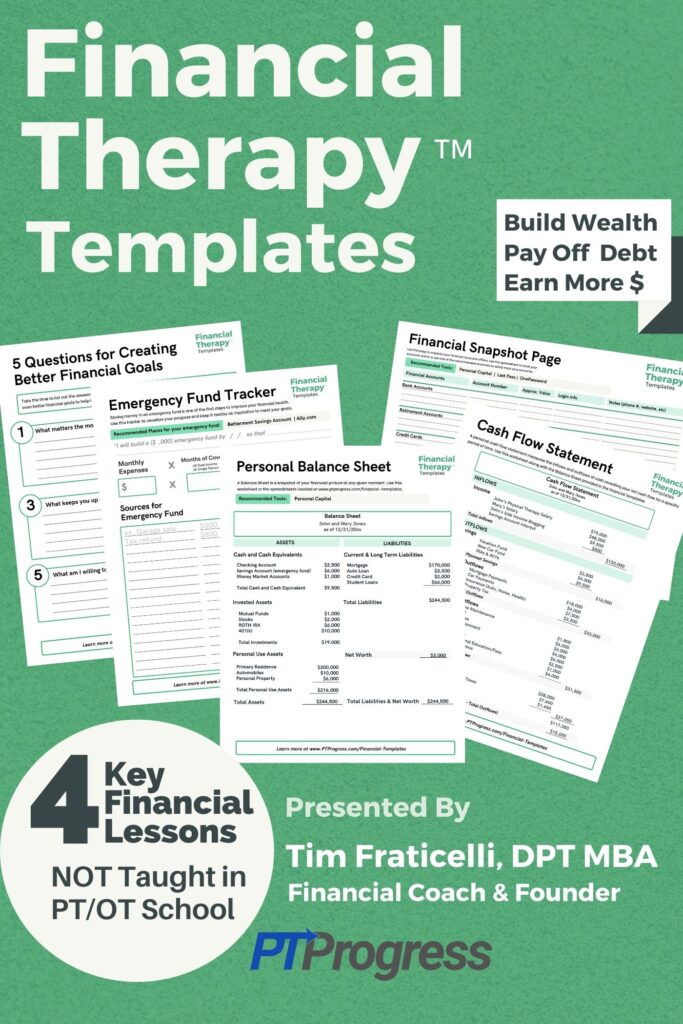There are a lot of broke PTs out there, but you don’t have to be one of them – especially if you follow my three principles for paying off physical therapy school debt.
3 Fast Ways to Pay Off Physical Therapy School Debt
And when I say “fast,” I mean relatively speaking. No get-rich-quick schemes here; rather, time-tested principles that will help you – once and for all – get rid of your crushing school debt.
Personal finance is meant to be personal, and I know that not everyone will like or agree with these principles. So let’s start with what most everyone will agree is your best implement for paying off physical therapy debt: your shovel.
1. Get a Bigger Shovel
The size of your shovel should be determined by the size of your mountain. I call this a debt-to-income ratio. If you owe over $150,000 in school loans but earn a $75,000 salary, you’ll need a bigger shovel, or even multiple shovels, to move that mountain of debt.
In order to achieve a better debt-to-income ratio, you need to start earning more than the average PT starting salary of $65–$70k a year. And that will take sacrifice.
Work Weekends
Start with your day job, where you work 40 hours a week. Instead of working five days in one job, reduce your work days to four. Working 4, ten hour days is not easy, but it opens up another day in the week for you to take on additional work in a different clinic or setting. I may also allow you to take a day of rest while working Saturday and Sunday in home health.
Ugh, working the weekends. I know it sucks. When I was starting out, I didn’t want to work the weekends either. But that’s the choice I made by going to one of the most expensive schools in the country and getting the bill for it.
Here’s what I recommend: work four days a week at the clinic, say, Monday through Thursday. On Friday, Saturday and Sunday, pick up shifts in home health or at a skilled nursing facility. With this schedule, you could make an additional $30-$40,000 a year.
What about burnout?
Maybe you’re worried that working more than 40–50 hours a week will cause burn out, and you’ll resent the job for taking over your life.
Well, shoot. Then I guess we should drop the title “Doctor” from these Doctor of Physical Therapy degrees. The last time I checked, most resident physicians, fellow “Doctors,” work up to 80 hours each week during their 3–5 year residency after medical school and earn less than $60k each year. Do you think they’re burnt out?
No one’s saying this work load is well-balanced or right, but plenty of medical professionals accept it as normal, even expected. When they chose a career in medicine, they accepted a heavy workload as par for the course. Similarly, you chose to go to physical therapy school and, by extension, borrow $150k+ in student loans. You signed up for hard work, both as a therapist and as someone who now has to pay off the debt!
There’s no easy way around it. If you want to get out of your student loan debt faster, get a bigger shovel. By adding a second job and working the weekends, you’ll be able to apply $30-$40,000 each year towards your student loans. At that pace, you’d get out from under the deck within five years. So treat it like a residency!
2. Stop Adding Debt
My second principle for paying off physical therapy school may not be popular, but it’s critical. As you shovel out your mountain of debt, don’t add to the pile!
The Danger of Funny Money
It’s possible to be so deep in debt that you think you’ll be in debt forever, so what’s the point? Carrying so much debt can turn money into monopoly money – the numbers become absolutely mind-numbing, even paralyzing to think about. When your debt is in the six digits, what’s another $10k for a car loan?
Continuing to sign promissory notes when you’re already a heavy borrower is like adding gasoline to a fire. Not a good idea. If you want to repay your student loans within five years with your bigger shovel, you need to live like a student for the next five years and stop adding debt to the pile.
What do I mean by living like a student? I mean living in an apartment. Sticking to local vacations. Driving around a $5,000 Toyota Camry – and when that breaks down in 3 years, buying a $5,000 Honda Accord. The reality of your debt should change how you live: how you spend, how you save, and how you borrow.
The False Freedom of IDR
Income-driven Repayment plans portend to make your student loans more manageable by reducing your monthly payment in proportion to your current salary. Although this can help you catch your breath, it may give you a false sense of relief from your debt burden.
For a $150,000 debt balance and a $75,000 salary, an IDR payment will be too small to make a difference. You will never pay off your loans this way. And don’t put your hope in a 20- or 25-year grad school IDR forgiveness plan. The only thing forgiveness plans guarantee is a tax bomb of up to 50% of your current balance, owed upfront, on top of 25 years of continuous loan payments.
Your finances are in a state of emergency, and an IDR plan is essentially a Band-aid. While it can keep you from delinquency, it will keep you in debt longer. Plus, with your small monthly payment, you may forget about your debt crisis and live as if you’re able to afford things that you really cannot afford.
Income-based repayment plans provide a false sense of financial stability and can deceive you into thinking you can afford a mortgage or a car payment (not to mention credit card debt, averaged at $6,100 among Americans). Relying on an IDR plan to address your debt problem is like trying to put out a fire with a bucket of gasoline.
You are at war with your debt! Don’t settle for IDR! And don’t concede that paying it off is impossible. By making only the minimum payments, you’ll set yourself up for a life of living paycheck-to-paycheck as a broke PT.
The US government is not going to wage this war for you, so don’t wait around for the president to forgive your loans! Seize control over your finances yourself – reliably and realistically.
3. Live Below Your Means
The third principle for paying off your physical therapy school debt is to live below your means. But what does that look like for a physical therapist who earns $70k annually?
Look, there’s no doubt about it: physical therapists make a good living. The job is both challenging and rewarding, paying well above the average salary in America. You might think your means are cushier than most.
But because you owe $150,000 or more in student loan debt, you have to live below your means. It doesn’t matter that you have a doctorate degree. It doesn’t matter that all of your friends are getting houses and new cars after graduation. Who cares what your friends are buying? They’re just adding gasoline to the fire.
Living below your means is a discipline that you’ll be able to use towards other financial goals. Maybe you want to become financially independent, be your own boss, and retire when you want to and how you want to. By learning to live below your means now, you’ll free yourself from the burden of debt and end the cycle of living paycheck-to-paycheck as a broke PT.
Paying PT School Debt Takes Time and Effort
Paying down your physical therapy school debt doesn’t have to take your whole life long, but it does require dedicated consistency over several years of hard work. In order to pay off your school debt, you may have to follow these principles for four to five years.
PT school was no joke; you worked really hard to get to this point in your career. Don’t settle for a lifetime of borrowing. If you were able to put the work in for three years to get your DPT, you can put the work in for five more years to pay off that DPT so that you can spend the next 20+ years without the burden of student loans.
Imagine what you can do for yourself financially by adopting these principles! The same discipline that will pay off your student loans can help you max out your retirement account every year for the next five years.
Why would you want to do that? Well, a 30-year-old who maxes out their retirement account each year for five years and then stops saving altogether will have over $1.5 million by the time they reach retirement. That’s the magic of compounding – and the wisdom of saving!
How I Paid My Physical Therapy School Debt
I know what it’s like to have over $130,000 in student loans from physical therapy school. I’ll be the first to say that I paid too much for my degree (that’s why I encourage prospective PTs to pursue state schools).
Because of my debt, it took me four years of working over 60 hours each week to finally break even on my finances. I’m not saying these principles are easy. But physical therapy school wasn’t easy. Your job isn’t easy. Getting out of debt won’t be easy either.
You know what is easy? Remembering these three principles:
- Get a bigger shovel – and don’t be afraid of work.
- Stop borrowing – stop adding gasoline to the fire.
- Rein in your spending – live below your means.
I can help you break the cycle of debt with a few worksheets that I personally use to help track my spending and net worth. They’re free to download and available here!



